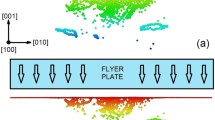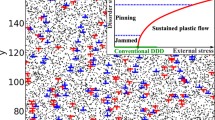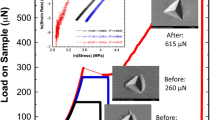Abstract
Indentation load–displacement curves for Mo (100) single crystals reveal clear displacement bursts from spherical indenters with various radii from ∼0.1 to ∼130 μm. There are two different size-dependent mechanisms for dislocation evolution involved during the displacement bursts. It has been postulated that these bursts are triggered by the nucleation of dislocations for a small indenter radius and the activation of preexisting dislocations for a large indenter radius. We present a simple model with which the displacement bursts from a larger indenter radius can be rationalized. This model relates the load and the excursion length during the first displacement burst. The correspondence between the model and experimental data indicates that the displacement bursts are initiated by the activation of preexisting dislocations and the model can accurately describe the mechanism for the displacement bursts from large indenters.





Similar content being viewed by others
References
W.C. Oliver and G.M. Pharr: Improved technique for determining hardness and elastic modulus using load and displacement sensing indentation experiments. J. Mater. Res. 7, 1564 (1992).
S.G. Corcoran, R.J. Colton, E.T. Lilleodden, and W.W. Gerberich: Anomalous plastic deformation at surfaces: Nanoindentation of gold single crystals. Phys. Rev. B 55, R16057 (1997).
C.A. Schuh, J.K. Mason, and A.C. Lund: Quantitative insight into dislocation nucleation from high-temperature nanoindentation experiments. Nat. Mater. 4, 617 (2005).
P.R. Cha, D.J. Srolovitz, and T.K. Vanderlick: Molecular dynamics simulation of single asperity contact. Acta Mater. 52, 3983 (2004).
K.J. Van Vliet, J. Li, T. Zhu, S. Yip, and S. Suresh: Quantifying the early stages of plasticity through nanoscale experiments and simulations. Phys. Rev. B 67, 104105 (2003).
A. Gouldstone, K.J. Van Vliet, and S. Suresh: Nanoindentation: Simulation of defect nucleation in a crystal. Nature 411, 656 (2001).
S. Shim, H. Bei, E.P. George, and G.M. Pharr: A different type of indentation size effect. Scr. Mater. 59, 1095 (2008).
H. Gao, Y. Huang, W.D. Nix, and J.W. Hutchinson: Mechanism-based strain gradient plasticity -I. J. Mech. Phys. Solids 47, 1239 (1999).
S. Qu, Y. Huang, G.M. Pharr, and K.C. Hwang: The indentation size effect in the spherical indentation of iridium: A study via the conventional theory of mechanism-based strain gradient plasticity. Int. J. Plast. 22, 1265 (2006).
W.W. Gerberich, S.K. Venkataraman, H. Huang, S.E. Harvey, and D.L. Kohlstedt: The injection of plasticity by millinewton contacts. Acta Metall. Mater. 43, 1569 (1995).
W.W. Gerberich, J.C. Nelson, E.T. Lilleodden, P. Anderson, and J.T. Wyrobek: Indentation induced dislocation nucleation: The initial yield point. Acta Mater. 44, 3585 (1996).
D.F. Bahr, D.E. Kramer, and W.W. Gerberich: Non-linear deformation mechanisms during nanoindentation. Acta Mater. 46, 4605 (1998).
W.W. Gerberich, D.E. Karmer, N.I. Tymiak, A.A. Volinsky, D.F. Bahr, and M.D. Kriese: Nanoindentation-induced defect-interface interactions: Phenomena, methods and limitations. Acta Mater. 47, 4115 (1999).
A. Gouldstone, H.J. Koh, K.Y. Zeng, A.E. Giannakopoulos, and S. Suresh: Discrete and continuous deformation during nanoindentation of thin films. Acta Mater. 48, 2277 (2000).
W.W. Gerberich, W.M. Mook, M.D. Chambers, M.J. Cordill, C.R. Perrey, C.B. Carter, R.E. Miller, W.A. Curtin, R. Mukherjee, and S.L. Girshick: An energy balance criterion for nanoindentation-induced single and multiple dislocation events. J. Appl. Mech. 73, 327 (2006).
Y. Shibutani, T. Tsuru, and A. Koyama: Nanoplastic deformation of nanoindentation: Crystallographic dependence of displacement bursts. Acta Mater. 55, 1813 (2007).
H. Bei, Y.F. Gao, S. Shim, E.P. George, and G.M. Pharr: Strength differences arising from homogeneous versus heterogeneous dislocation nucleation. Phys. Rev. B 77, 060103 (2008).
D. Lorenz, A. Zeckzer, U. Hilpert, and P. Grau: Pop-in effect as homogeneous nucleation of dislocations during nanoindentation. Phys. Rev. B 67, 172101 (2003).
J.R. Morris, H. Bei, G.M. Pharr, and E.P. George: Size effects and stochastic behavior of nanoindentation pop in. Phys. Rev. Lett. 106, 165502 (2011).
K.L. Johnson: Contact Mechanics (Cambridge University Press, Cambridge, 1985).
G. Simmons and H. Wang: Single Crystal Elastic Constants and Calculated Aggregate Properties–A Handbook (MIT Press, Cambridge, MA, 1971).
S. Ogata, J. Li, N. Hirosaki, Y. Shibutani, and S. Yip: Ideal shear strain of metals and ceramics. Phys. Rev. B 70, 104104 (2004).
H. Bei, S. Shim, G.M. Pharr, and E.P. George: Effects of pre-strain on the compressive stress-strain response of Mo-alloy single-crystal micropillars. Acta Mater. 56, 4762 (2008).
D.M. Dimiduk, M.D. Uchic, and T.A. Parthasarathy: Size-affected single-slip behavior of nickel microcrystals. Acta Mater. 53, 4065 (2005).
C. Zhou, S.B. Biner, and R. LeSar: Discrete dislocation dynamics simulations of plasticity at small scales. Acta Mater. 58, 1565 (2010).
J. Senger, D. Weygand, P. Gumbsch, and O. Kraft: Discrete dislocation simulations of the plasticity of micro-pillars under uniaxial loading. Scr. Mater. 58, 587 (2008).
K.L. Johnson: The correlation of indentation experiments. J. Mech. Phys. Solids 18, 115 (1970).
H. Bei, Z.P. Lu, and E.P. George: Theoretical strength and the onset of plasticity in bulk metallic glasses investigated by nanoindentation with a spherical indenter. Phys. Rev. Lett. 93, 125511 (2004).
W. Zielinski, H. Huang, and W.W. Gerberich: Microscopy and microindentation mechanics of single crystal Fe-3 wt.%Si: Part II. TEM of the indentation plastic zone. J. Mater. Res. 8, 1300 (1993).
Z.W. Shan, R.K. Mishra, S.A. Syed Asif, O.L. Warren, and A.M. Minor: Mechanical annealing and source-limited deformation in submicrometre-diameter Ni crystals. Nat. Mater. 7, 115 (2008).
F. Guiu and P.L. Pratt: The effect of orientation on the yielding and flow of molybdenum single crystals. Phys. Status Solidi B 15, 539 (1966).
H. Bei, S. Shim, E.P. George, M.K. Miller, E.G. Herbert, and G.M. Pharr: Compressive strengths of molybdenum alloy micro-pillars prepared using a new technique. Scr. Mater. 57, 397 (2007).
M.V. Swain and B.R. Lawn: A study of dislocation arrays at spherical indentations in LiF as a function of indentation stress and strain. Phys. Status Solidi 35, 909 (1969).
Author information
Authors and Affiliations
Corresponding author
Rights and permissions
About this article
Cite this article
Shin, C., Shim, S. Dislocation mechanisms of radius effect on displacement bursts during spherical nanoindentations. Journal of Materials Research 27, 2161–2166 (2012). https://doi.org/10.1557/jmr.2012.183
Received:
Accepted:
Published:
Issue Date:
DOI: https://doi.org/10.1557/jmr.2012.183




